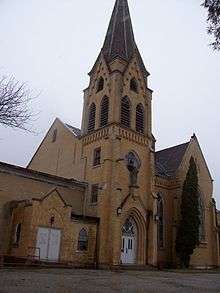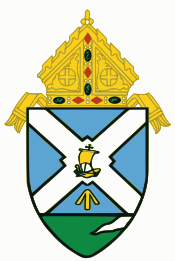St. Ambrose Church (St. Nazianz, Wisconsin)
St. Ambrose Church is a Roman Catholic church in St. Nazianz, Wisconsin, built in 1898.

History
In 1854 an entire Catholic parish in a small German village uprooted under the leadership of its priest, Father Ambrose Oschwald, and departed for America. Arriving in Wisconsin, a scouting party headed out through the forest with ox carts to locate the land and begin the settlement. Property was held in common and the community, along intensely Catholic lines, was governed by an Ephorate or senate.
The colony lasted until 1873 when Oschwald died, leaving "The Association" in a legal battle to preserve its land. In 1896, the Salvatorian order assumed responsibility for the Catholic institutions in St. Nazianz, building a new church and monastery on the grounds of the old Loretto Monastery just south of the village. In 1939, the Salvatorian Seminary was opened on the same grounds. The building later became John F. Kennedy Preparatory High School in the 1960s but closed in 1982.
From the point onward, the religious architectural complex lay abandoned and dormant, suffering a great deal of vandalism from gang activity on the premises. It served intermittently as a haunted house in the fall for a few years. After a series of owners and failed schemes, not much has changed in the present day, although Dale Ristow has refurbished the gymnasium enough to be used as an indoor soccer practice space. The old football field outside is also utilized. Additionally, portions of the more modern priest dormitories have been remodeled.
Oschwald's sarcophagus is kept in the hillside crypt at the rear of the property below the little Loretto Chapel on the hilltop above the cemetery. Originally, Oschwald's body was entombed beneath the altar of St. Ambrose Chapel in the space that now comprises the back of the main St. Ambrose Church (the chapel was the original worship place of the Loretto Monastery portion of the building, a lower stucco part which was constructed in the 1860s).
References
External links
- Meyer, Amy (April 30, 2016). "St. Nazianz Seminary left its mark". Herald Times Reporter. Retrieved April 6, 2017.
